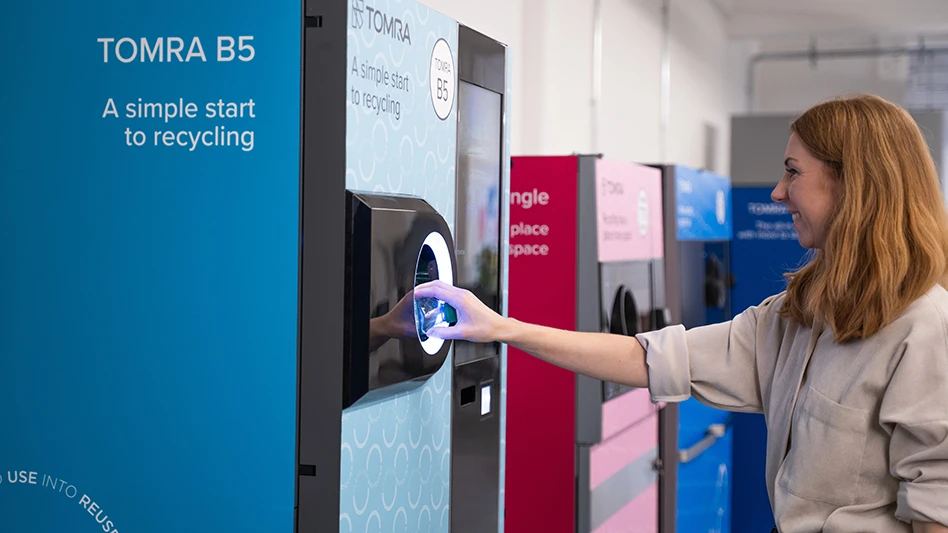
Photo courtesy of CATL and the Ellen MacArthur Foundation
During London Climate Action Week in late June, battery manufacturer Contemporary Amperex Technology Co. Ltd. (CATL) and the Ellen MacArthur Foundation shared their ambition for accelerating the transition to a circular economy for batteries, emphasizing that new battery production must be decoupled from the use of virgin raw materials.
According to the firms, doing so will “enable a future where access, resilience and sustainability go hand in hand, and where growth is no longer tied to extraction.”
RELATED: CATL, Ellen MacArthur Foundation establish battery partnership
Since forming their strategic partnership earlier this year, China-based CATL and the United Kingdom-based Ellen MacArthur Foundation have been working to map out how circular economy principles can be applied across the battery value chain.
In London, they said their shared ambition is intended to guide not only CATL, considered the largest battery producer in the world, particularly for electric vehicle (EV) batteries, but for a broad range of global stakeholders seeking to redesign the system for long-term success.
The ambition was introduced in London by Jiang Li, vice president and board secretary of CATL at a panel hosted by the foundation. The panel explored how stakeholders across research, industry and government can work together to enact this ambition and identify what is needed to achieve it at scale.
To bring the topic into focus, CATL introduced a directional goal: that within 20 years, 50 percent of new battery production could be decoupled from virgin raw materials. The collaborators said this is a long-term marker that will guide how they explore circular models, scale partnerships and invest in innovation across the value chain.
An industry guide
At the heart of the firms’ ambition are four principles, adapted from the foundation’s circular economy framework. The partners noted that the principles are designed to guide transformation across the battery value chain, from mining and manufacturing to mobility and energy systems, and offer a starting point to create further alignment with key stakeholders to design collaborative action to accelerate the shift toward a more circular battery economy.
The principles include:
- Rethinking systems. The firms say a circular approach requires systemic change across the battery ecosystem. By embedding circularity into each stage of the value chain, it becomes possible to support low-carbon development, reduce scrap and enable the continuous flow of materials. This principle emphasizes optimizing the structure and interactions of the value chain to enable more efficient and resilient use of resources.
- Redesigning products. The partners say circularity begins at the design stage, and batteries must be built for longevity, disassembly and second-life applications using modular architecture and durable components. Designing with reuse and recycling in mind ensures that products can retain value for longer and be recovered more efficiently at the end of life.
- Rethinking business models. New business models are essential to decoupling resource use from economic growth, the firms say, adding that by shifting from traditional ownership to shared, service-based or second-life models, batteries can deliver greater utility and become more accessible to users. They say this principle supports the creation of economically viable pathways for circularity to scale.
- Recycling materials. The firms note that a high-performing recycling system is essential to circularity. Materials must be recovered efficiently and returned to high-value use, increasing the proportion of closed-loop recycling. The firms add that this reduces dependence on virgin resources and helps establish a more sustainable, secure and low-impact supply of critical raw materials.
Li also shared examples of CATL’s implementation of the four pillars:
- At the system level, Li said the company launched its carbon chain management system to help decarbonize the battery value chain.
- In product design, CATL has extended battery lifespan significantly, according to Li, and its energy storage batteries now reach up to 18,000 cycles, reducing both materials demand and emissions.
- CATL also plans to deploy more than 10,000 battery swap stations, improving battery efficiency and facilitating large-scale collection of retired batteries.
- In recycling, Li claimed CATL operates the world’s largest battery takeback network, and in 2024 alone, the company recycled around 130,000 tons of end-of-life batteries, recovering 17,000 tons of lithium cells.
To test and expand on the shared ambition in real-world conditions, Li said CATL is advancing the Global Energy Circularity Commitment (GECC). Announced in March, the GECC is an open, global platform where stakeholders from industry, cities and academia come together to test circular economy solutions in practice. Li said CATL aims to work with players across the value chain through this platform, exploring and sharing insights to help scale impact.
CATL and the foundation said they will continue to engage with public and private sector partners to refine, expand and operationalize their ideas.
“The circular battery system won’t be built in a lab or a boardroom—it will be shaped through collaboration, testing and shared effort,” Li said. “This ambition is a signal to help drive that work forward. Achieving it will require global collaboration, cross-sector learning and open engagement across the value chain—all of which the Ellen MacArthur Foundation has long championed.”
Latest from Recycling Today
- ReMA urges open intra-North American scrap trade
- Axium awarded by regional organization
- China to introduce steel export quotas
- Thyssenkrupp idles capacity in Europe
- Phoenix Technologies closes Ohio rPET facility
- EPA selects 2 governments in Pennsylvania to receive recycling, waste grants
- NWRA Florida Chapter announces 2025 Legislative Champion Awards
- Goldman Sachs Research: Copper prices to decline in 2026





